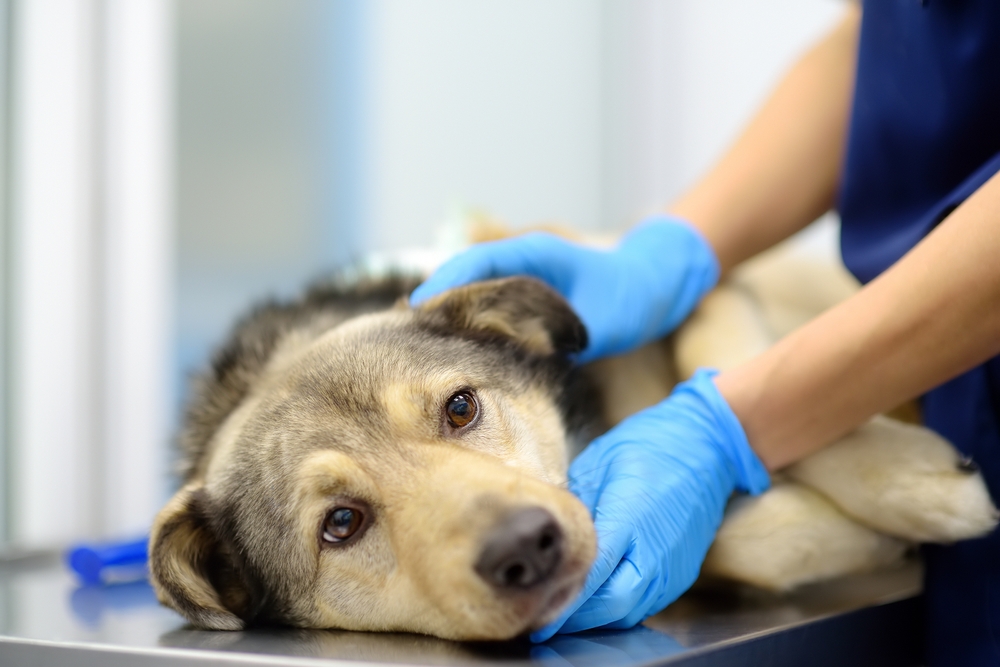Click to Skip Ahead
You notice bald spots on your dog, and you’re not sure if he’s been itching more than normal. You mention your concern with your vet, and the doctor mentions mange. You’ve heard the term bandied about over the years, but what exactly is this skin condition?
What Is Mange?
You might have heard the term “mangy dog” before, but what is mange? A microscopic mite causes this skin condition.
- Demodectic mange
- Sarcoptic mange
Demodex, the causative agent of demodectic mange, is a cigar-shaped mite that tends to live deep in the skin, mainly in the hair follicles. It is normal to find very low numbers of Demodex on a dog’s skin—and even your own (although of a different species).
Sarcoptes mites are highly contagious and cause intense itching. They tend to live more superficially in the skin.

What Are the Signs of Mange in Dogs?
The most characteristic sign of mange in dogs is hair loss. The other signs depend on which type of mange your dog is affected by.
Demodectic Mange
Dogs with an overpopulation of Demodex may or may not be itchy or pruritic. There are two major forms of demodectic mange: localized and generalized. According to the Merck Veterinary Manual, most dogs with localized Demodex have, on average, one to five bald spots. Dogs with the generalized form can have large patches of alopecia or hair loss.
- Erythema (redness)
- Scaling skin
- Oily skin
- Severe cases may even show skin swelling and edema.
Sarcoptic Mange
Dogs with Sarcoptes are often quite itchy. A common trait that many affected dogs exhibit is the pinna-pedal reflex. If you rub the edge off the dog’s ear, they itch their body.
- Excoriations or crusts
- Reddened skin
- Secondary bacterial and yeast infections
What Are the Causes of Mange in Dogs?
Parasitic mites living in the skin cause mange. The main Demodex species we see in dogs is Demodex canis. Sarcoptes scabiei causes sarcoptic mange, also known as scabies.

Demodectic Mange
Demodectic mange generally occurs in immunocompromised individuals. These dogs are usually young, with what is known as a naive immune system. Older dogs can be affected, but they almost always have an underlying health condition, such as Cushing’s disease or hypothyroidism. While Demodex is not considered contagious to other dogs, puppies are exposed when they nurse from their mother, particularly in the first 72 hours of life.
Sarcoptic Mange
Sarcoptic mange occurs when your dog is exposed to an animal with scabies or comes into contact with a fomite. Fomites are reservoirs for infection, such as brushes or combs, bedding, and even you. This mite is contagious to people. Often, a wild animal is the reservoir for scabies. These mites can affect foxes, coyotes, and more and transmit them to your dog.
Diagnosing Mange
The first step to treating your dog for mange is getting a diagnosis. Many things can cause hair loss and itching in dogs, from fleas to food allergies. You should consult with a veterinarian. Your vet will likely start with a skin scraping. Using a scalpel blade, they’ll scrape away a layer of cells from bald areas on your dog. Typically, your veterinarian will scrape superficially when looking for Sarcoptes and scrape a bit deeper to look for Demodex. They might also pluck some hairs to look for mites. Demodex mites are typically easy to find on skin scrapes, whereas scabies mites are only found 20-50% of the time depending on the number of sites scraped.

Treating Mange in Dogs
Demodectic Mange
Most cases of localized demodicosis are self-limiting and will resolve on their own. Treatments for generalized demodicosis have varied over the years. There are topical and oral therapies, many of which are used off-label in veterinary medicine.
- Ivermectin
- Milbemycin
- Moxidectin
- Isoxazolines (e.g. fluralaner, afoxolaner, and sarolaner)
Isoxazoline medications, commonly used as flea prevention products, have been incredibly helpful in reducing the occurrence of mange in dogs in recent years. While only some of these products are licensed to treat demodex, the dosing and frequency are the same as using them for their intended preventative purposes. Because many pet owners use these products for their dogs, we see fewer cases of mange than we used to.
Your veterinarian might suggest a medicated shampoo, such as a benzoyl peroxide-based shampoo, to help open up the follicles on your affected dog and treat any secondary bacterial infections.
Sarcoptic Mange
Some of the possible treatment options for Sarcoptes include:
- Selamectin
- Moxidectin
- Milbemycin
- Ivermectin
- Isoxazolines
It’s important to note that, unlike with Demodex, all dogs in contact with the affected dog should be treated for Sarcoptes due to its highly contagious nature.
Frequently Asked Questions
How do I tell if a dog has mange?
Your veterinarian will generally need to perform specific tests to determine if your dog has mange.
- Skin scrapings
- Fecal floatation tests
- ELISA tests for Sarcoptes
- Skin biopsy
Is it safe to touch a dog with mange?
Dogs with Demodex are perfectly fine for you to touch. This mite is not contagious to other pets or people. In contrast, Sarcoptes mites can quickly spread between other pets and people, so you’ll want to be cautious about handling these dogs.

Conclusion
Mange is a common skin condition affecting some dogs. We see two major types of mange in dogs: sarcoptic and demodectic. This parasitic skin disease has become much less common in recent years due to the widespread usage of routine prevention products for fleas and heartworms, particularly isoxazoline products.
Featured Image Credit: Todorean-Gabriel, Shutterstock














